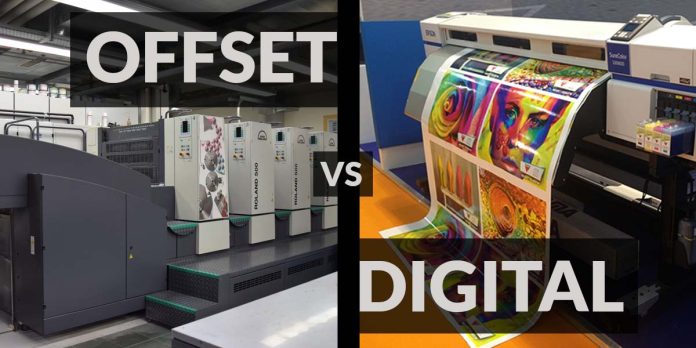In a world increasingly conscious of environmental sustainability, the choices we make in our everyday activities extend beyond just personal habits. The printing industry, a significant player in business and communication, is transforming greener alternatives. This article delves into the nuances of sustainable print choices, specifically focusing on the environmental impacts of offset and digital printing methods.
The Environmental Landscape
Offset Printing: Balancing Act
Offset printing, a traditional method revered for its high-quality output relies on a delicate equilibrium of ink, water, and chemistry. The process involves transferring ink from a plate to a rubber blanket, which is then applied to the printing surface. While the setup and materials for offset printing may carry a heavier initial environmental footprint, its efficiency in large-scale production often results in a lower impact per unit.
Digital Printing: Precision with a Conscience
On the other side of the spectrum, digital printing stands as a more contemporary, eco-friendly alternative. This method eliminates the need for printing plates, reducing waste and chemical usage. Digital printing allows for on-demand printing, minimizing excess inventory and further contributing to a smaller environmental impact.
Eco-Impacts Unveiled
Offset’s Resource Intensity
The resource intensity of offset printing lies in its setup. The production of printing plates, the need for large volumes to justify costs, and the requirement for specialized inks contribute to its environmental impact. However, once the initial hurdles are surpassed, the efficiency of the offset process can lead to a lower impact per unit when handling substantial print volumes.
Digital Printing’s Streamlined Approach
Digital printing, hailed for its on-demand capabilities, significantly reduces waste associated with traditional printing methods. The absence of printing plates and the ability to print variable data contribute to a more sustainable printing model. However, concerns arise regarding the energy consumption of digital printing machines, especially in comparison to the high-volume efficiency of offset printing.
Factors Influencing Choice
Quantity Matters
The choice between offset and digital printing often hinges on the scale of the printing project. For larger quantities, offset printing’s efficiency can outweigh its initial environmental impact. Conversely, digital printing excels in scenarios demanding shorter print runs and personalized content.
Ink and Chemical Considerations
The type of ink used plays a crucial role in the eco-impact. Vegetable-based inks, soy inks, and other eco-friendly alternatives are gaining traction in both offset and digital printing. Additionally, the chemicals involved in the offset process raise environmental concerns, emphasizing the need for responsible disposal practices.
A Holistic Perspective
Certifications and Sustainable Practices
Both offset and digital printing can be part of a sustainable printing ecosystem. The adoption of environmentally friendly practices, certifications such as FSC (Forest Stewardship Council), and a commitment to recycling and responsible waste management are pivotal in minimizing the ecological footprint of print production.
Printed Packaging as a Communication Tool
Beyond Aesthetics: A Message of Sustainability
Printed packaging serves not only as a protective shell for products but also as a powerful communication tool. Companies embracing sustainability can convey their commitment through eco-friendly packaging designs. Informative prints about the environmental benefits of the chosen materials, recycling instructions, and certifications contribute to an educated consumer base, fostering a sense of shared responsibility.
Read More: Where to Find the Best Eco-Friendly Packaging Materials in 2024
Reducing Waste Through Smart Design
Minimizing Environmental Impact Through Thoughtful Design
Collaboration between packaging and printing experts in the design phase is critical for waste reduction. Optimal printing techniques, such as flexography or digital printing, allow for precise control over ink application, minimizing excess. Smart design strategies, such as right-sizing packages to fit products snugly, not only reduce material consumption but also enhance overall sustainability.
Lifecycle Considerations for Sustainability
From Creation to Disposal: A Holistic View
Sustainability in packaging and printing extends beyond the manufacturing stage. Considering the entire lifecycle of a product, from creation to disposal, is essential. Companies are increasingly investing in designs that facilitate recycling and adopting circular economy principles, ensuring that materials used are not only eco-friendly but also contribute to a closed-loop system.
Consumer Education for Conscious Choices
Empowering Consumers Through Knowledge
Both packaging and printing play a crucial role in educating consumers about sustainable practices. Clear labeling, eco-friendly certifications, and informative prints on packaging materials guide consumers to make environmentally conscious choices. This collective effort transforms consumers into advocates for sustainability, driving demand for greener packaging and printing practices.
The Collaborative Future
A Shared Commitment to a Greener Tomorrow
As we move forward, the collaboration between sustainable packaging and printing practices is not just a trend; it’s a fundamental shift in industry norms. Embracing this shared commitment to sustainability, companies can enhance brand reputation, meet consumer expectations, and contribute to a healthier planet.
In the ever-evolving landscape of packaging and printing, the synergy of sustainable practices emerges as a powerful force for positive change. By combining innovative technologies, eco-friendly materials, and a commitment to consumer education, the collaborative efforts of these two industries pave the way for a greener, more sustainable future.
Conclusion
In the realm of sustainable print choices, understanding the eco-impact of offset and digital printing is imperative. Each method has its strengths and weaknesses, and the decision between them should align with the specific needs of the printing project. By embracing eco-friendly practices, considering factors like quantity and ink types, and staying abreast of sustainable certifications, the printing industry can pave the way towards a greener future.


